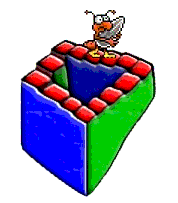-
|
| .
|

Guru
- Group
- Administrator
- Posts
- 1,911
- Reputation
- +27
- Location
- Belluno - Italy
- Status
- Offline
|
|
Drawing formers for fuselage with a complex shape and angled surface may be challenging in devFus.
Both devFus (for creating interpoled formers) and devFus Foam (to keep the cutting path synchronized) must take care of possible synchro points on the former contour.
Synchro points are couple of control points matched between two near formers.
For example when we go to cut a fuselage block, the cutting wire will reach coupled synchro points at the same time.
This is important when you have an angled surface, or generally when the surface has a big change in the curvature.
devfus automatically takes care of those synchro points, and to know how it works is very important to create a good project.
There are different levels of synchro points, let's give a list from those with higher priority:
- Main Syncro points - These syncro points are defined at upper/lower mid points and where the rounding of the corners starts/end
If the rouding is full size some syncro points can be overimposed, but devFus takes care of that. These syncro points split the external contour in more curevs, and now each curve is processed together the referring curve of the nearest control former.
If no more custom control points are included, the matching curves will be interpolated by the application by the same number of internal points, and they will be used to create the cutting path of the hotwire. The number of control points varies depending on the tolerance, curve length and so, the application take care of that.
See the picture that shows Main Synchro points:
If you select to work with custom rounding you can insert new control points to define its shape.
You can insert both Smooth and Angled control points.
Angled control points are useful when the surface of the fuselage perform an angle.
In this case new levels of synchro points will be created:
- Angled Synchro points - if two matching rounding (the rounding of the same part of two near formers) have the same number of Angled custom control points, those 2 rounding curves will be splitted again in more matching curves. If for example you add 2 Angled custom control points to each rounding, the original roundings will be split in 3 little curves. If the number of Angled custom control points is different devFus doesn't split the rounding. THIS IS GENERALLY A BAD CONDITION. WE SUGGEST ALWAYS TO GET THE SAME NUMBER OF Angled custom control points. YOU CAN ADD 2 ATTACHED FORMERS WHERE AN ANGLED SHAPE FINISHES OR BEGINS.
Now we have 2 possibilites:
a) The roundling was splitted in more curves
b) The roundling was NOT splitted in more curves
Case a):
in this case devFus takes a look at the number of Smooth control points for each couple of matching curves.
If the number is the same, again it split those curves, if not it does'n split
Case b):
in this case devFus takes a look at the total number of control points for each couple of matching curves.
If the number is the same, again it split those curves, if not it does'n split
Now devFus simply interpolates each couple of matching curves by the same number of internal points, and they will be used to create the cutting path of the hotwire. The number of control points varies depending on the tolerance, curve length and so, the application take care of that.
IN BRIEF: To have the best result always use the same number of Angled and Smooth control points. In this way devFus can apply a clear logic to interpolate and create good interpolate formers (devFus) or good cuttings (devFus Foam).
Edited by duroneee - 7/4/2013, 13:27
|
|
|
| .
|
0 replies since 5/4/2013, 11:23 1290 views
.
